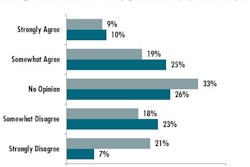The process by which new petfood ingredients are approved and defined in the US is, well, complicated. But for the most part, the process has worked, based on cooperation between the Association of American Feed Control Officials and US Food and Drug Administration. Last week, the memorandum of understanding that underpins that collaborative process was extended for one year.
First issued in 1980, FDA's Compliance Policy Guide Sec. 665.100 "recognizes AAFCO definitions as constituting the common or usual names for animal feed ingredients, including those for use in petfood, as contemplated by the Federal Food, Drug and Cosmetic Act (FFDCA) for purposes of proper label declaration," wrote David Dzanis, DVM, PhD, DACVN and CEO of Regulatory Discretion Inc., in his April 2012 "Petfood Insights" column. "In turn, FDA has assisted AAFCO by providing scientific support in assessment of the safety and utility of proposed ingredients. In 2007, both organizations agreed to a set of conditions by which this cooperative effort could continue."
The agreement was set to expire this September; it was extended for 12 months while several feed, grain and petfood associations, led by the American Feed Industry Association, work to persuade the US Congress to embed formal recognition of AAFCO feed ingredient definitions directly into FFDCA, Dzanis said. The intent is to eliminate FDA's current concerns about the process, which revolve around the fact that AAFCO definitions are established using informal procedures; thus, FDA's lack of objection to an ingredient that has gone through the process is based on enforcement discretion. The agency's general counsel had advised it that the discretionary policies need to be cut back, and all new ingredients should undergo more formal review and acceptance procedures. "In fact, there is an indication that eventually all ingredients, even those already defined by AAFCO and used for many years, would be subject to reevaluation under this new FDA paradigm," Dzanis wrote in April.
Now any new paradigm or policy has been put on hold for at least 12 months and will possibly not come into existence if AFIA's and other's efforts at a legislative solution are successful. But, is that a good thing? The answer probably depends on your point of view and position relative to the industry (manufacturer, supplier, regulator or consumer.)
In his column, Dzanis characterized the AAFCO ingredient definition process as informal compared to a food additive petition -- a formal petition to FDA -- and the generally recognized as safe, or GRAS, determination. But that latter process carries its own share of concern, confusion and complexity.
A recent front-page article in the Chicago Tribune about the safety of ingredients for human food highlighted the concerns, leaning heavily toward criticism of the process, and the confusion by blatantly misstating what the GRAS process does (or doesn't do). The FDA "acknowledges that since 1997, it has largely transferred the responsibilities for pre-market safety determination on ingredients -- including flavorings, preservatives, texturizers and binders -- from its own scientists to food manufacturers," wrote the reporter, Monica Eng.
It's true that the GRAS process has been in place for human foods since 1997; it was extended to feed and petfood ingredients in 2010. Yet for FDA to accept a GRAS notification (which means it issues no questions), the manufacturer must still prove the food or ingredient has passed an in-depth, independent safety review. In a 2010 column, Dzanis described the requirements and process of a GRAS notification, which include (but are not limited to):
- Compiling a dossier of all available information on the substance; the bulk of that information -- and particularly, all the pivotal data supporting safe use -- must be in the public domain, such as peer-reviewed, scientific journals.
- Having an unbiased, expert panel review the dossier; a minimum of three panelists must vary in expertise so all aspects (e.g., nutrition, toxicology) are covered.
- Showing the panel reached consensus that there is reasonable certainty of no harm under the intended conditions of use.
Only with all that evidence can the manufacturer submit the GRAS notification to FDA. So, for Eng's paper and other critics to say that "too often, the US lets manufacturers make the call on their own products" is rather misleading and misinformed.
No one in the human food or petfood industry would argue the GRAS notification process is perfect. In fact, in her article, Eng includes quotes from experts who argue that while GRAS could be improved, it works because the market works. "Who would want to take on an ingredient that could result in a lawsuit, or God forbid, hurt someone?" said John Endres, chief scientific officer of AIBMR Life Sciences.
Or, as another expert put it: "Sick customers are bad business."
The AAFCO definition process for feed and petfood ingredients isn't perfect, either, and likely wouldn't be even if it becomes part of federal law. But the fact is, FDA simply doesn't have the resources, and probably never will, to perform a thorough, scientific evaluation of all ingredients and foods. To completely throw out the various ingredient approval processes that have been developed to compensate for that reality would cause much of the innovation and advances in health and nutrition in both human foods and petfoods -- which consumers have shown they want, need and will pay for -- to grind to a halt, because few new ingredients or foods would make it to market. And that wouldn't be a positive step for anyone.


















